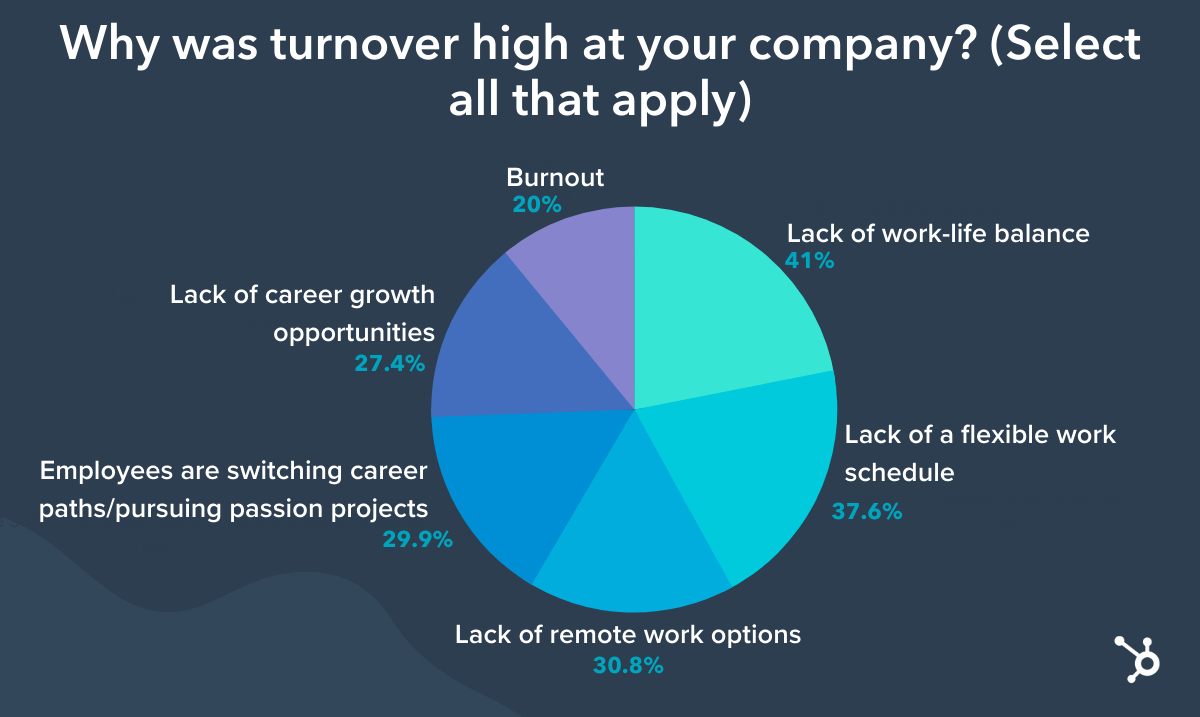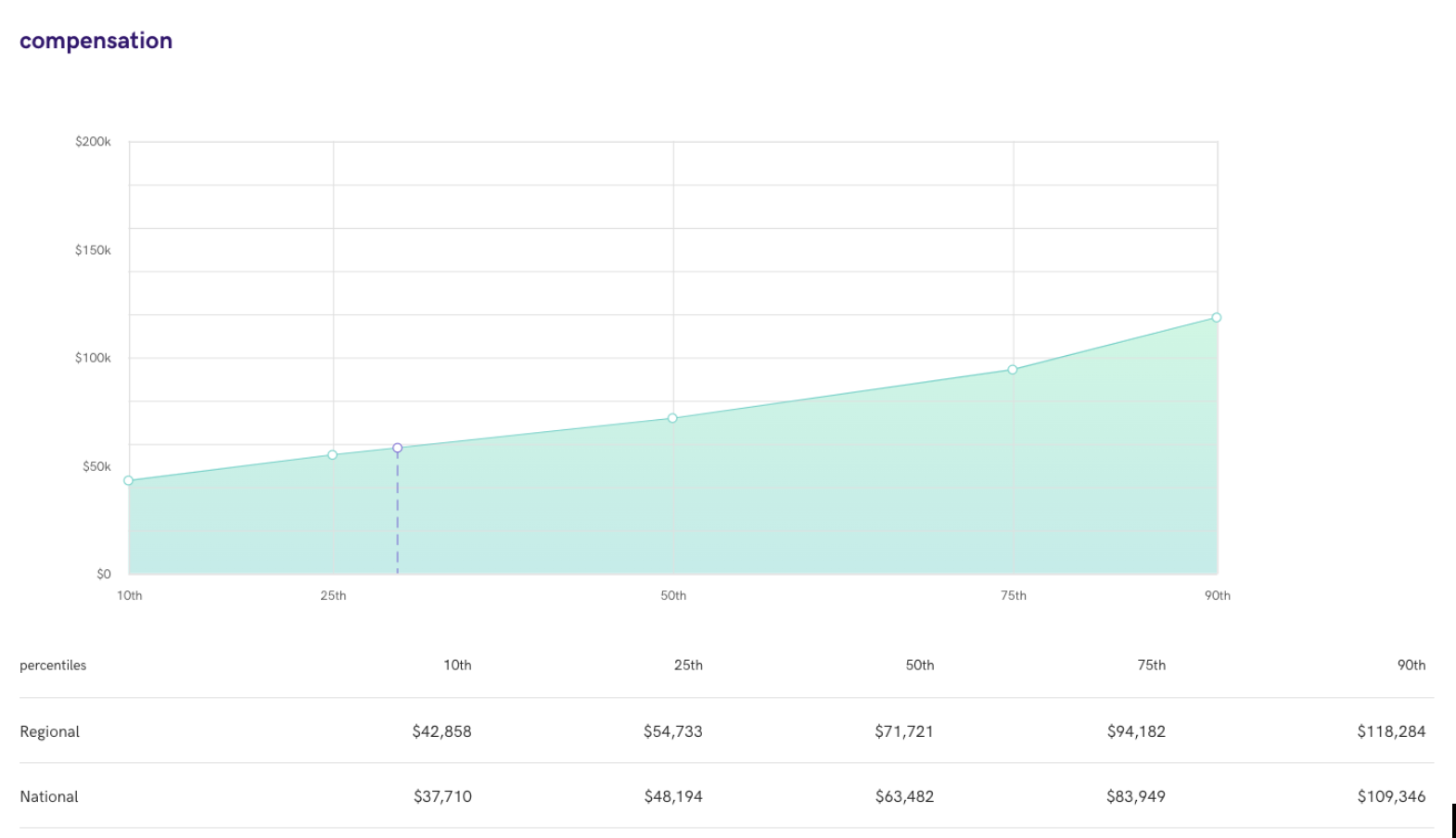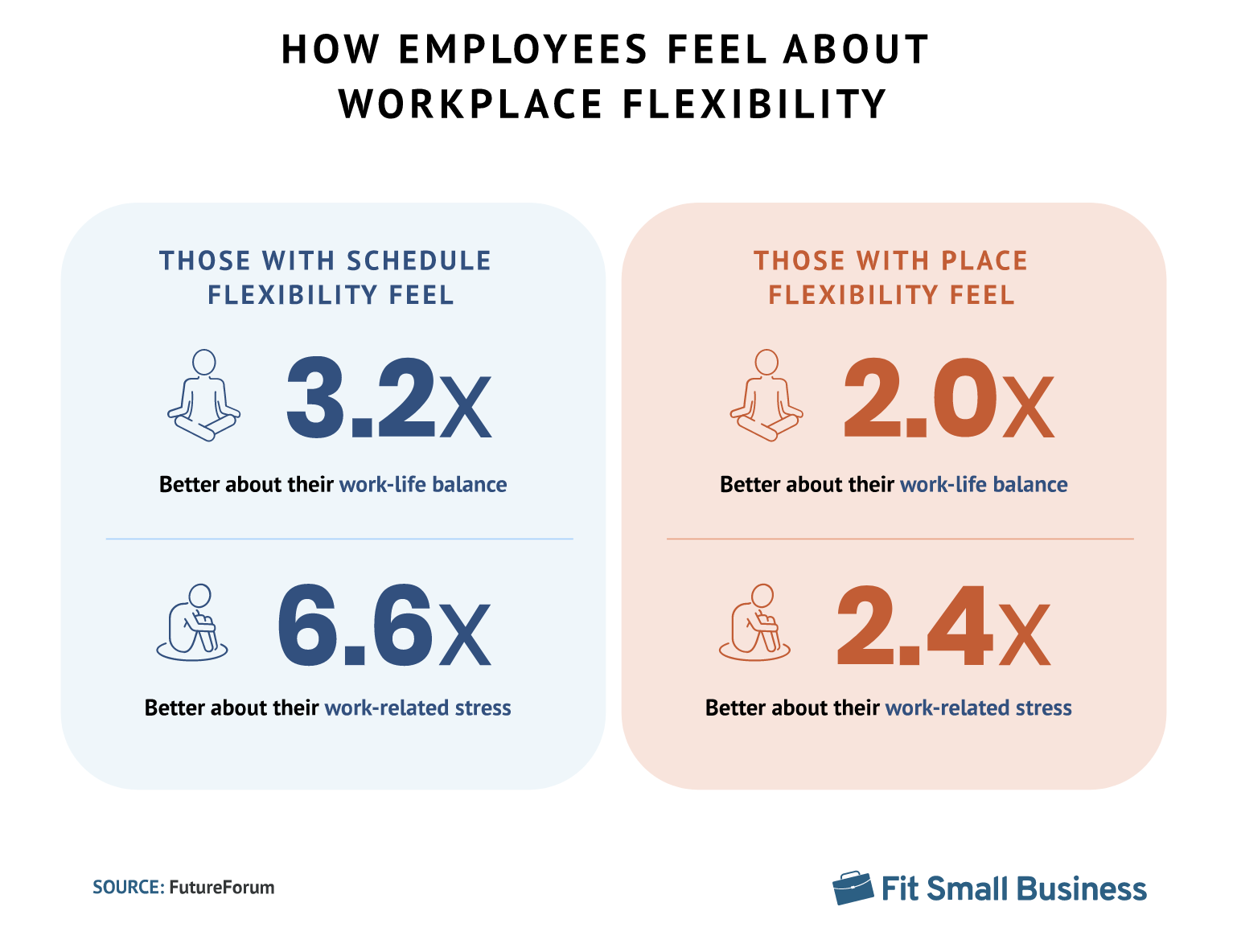Organizations are struggling with employee turnover worldwide, prompting a hard look at retention best practices.
Data from the BLS shows an average of 4 million people are voluntarily leaving their jobs every month, ebbing and flowing as the economy, COVID-19 waves, and other factors come into play [*].
Gallup and Work Institute research shows [*] [*]
- nearly half of U.S. workers (48%) are actively job searching or watching for new job opportunities.
- more than one in three workers will voluntarily quit by 2023.
- the cost of employee turnover is roughly 30% of the leaving employee's salary. So if someone earning $65,000/year quits, their departure could cost your company nearly $20,000.
But all that stress and expense can be avoided when your team implements a few practices to support employee retention. In fact, that same data shows three in four employee turnovers are actually preventable [*].
So let’s take a look at the biggest reasons employees are looking for greener pastures, then discuss eight steps your team can take to address them.
Employee retention in 2022: why talent’s leaving
According to a survey conducted by HubSpot, companies are blaming these obstacles for their recent turnover rates [*]:
- lack of work-life balance (41%)
- lack of a flexible work schedule (37.6%)
- lack of remote work options (30.8%)
- employees pursuing new career paths (29.9%)
- lack of career growth opportunities (27.4%)
- burnout (20%)
Notice a trend here? Employees experiencing a lack of something they deem a key value for their happiness, start to look elsewhere to fulfill that need.

Throughout the COVID-19 pandemic, employees have been leaving en masse in what’s now known as “The Great Recession.” This created our current candidate-driven market -- where workers have no shortage of organizations courting their favor.
Employees are placing more value on tangibles like mental health benefits, hybrid or fully remote work schedules, unlimited PTO, etc. So they’re naturally gravitating toward companies that understand and cater to these desires.
Fact: employee turnover can be prevented by employers
Are employees already looking for greener pastures a lost cause? Yes and no.
While it’s true that these employees may have one foot out the door, research reveals that [*][*]:
- 52% of departing employees say their organization could have done something to keep them.
- 78% of the reasons cited for leaving could have been prevented or mitigated by employers.
So if the majority of employees are willing to work with their employers to stay, it’s up to your company to take proactive steps to keep them happy, engaged, and loyal.
The perks of prioritizing employee retention
Brainstorming an employee retention strategy with your team is the best solution to combating this growing workforce problem. Besides increasing retention, your organization will also:
- save money on hiring expenses and replacement downtime
- boost productivity
- increase team morale
- build employee loyalty
- maintain customer satisfaction
- improve your brand image and values
Each of those benefits translates to a more engaged workforce that ultimately generates more revenue (which more than makes up for the costs associated with better retention strategies).

So let’s talk about how to put these retention best practices into action.
Retention best practices that actually work
1. Emphasize a healthy work-life balance in your company culture
One of the biggest hiring predictions for the post-COVID world is a greater emphasis on a healthy work-life balance. But it’s one thing to preach about disconnecting from work during your interviews, and another to practice it at every level of your organization.
Allowing managers to message employees outside of work hours, forcing teams to regularly work overtime to meet deadlines, limiting vacation time -- these are all signs of an unhealthy work-life balance.
And employees are tired of it. When they reach a certain level of stress and succumb to the feelings of burnout, all they want to do is run the other way.
So before they quit, reassess how your employees feel about the impact their workloads have on their lives outside of work. Manage appropriate coverage so they don’t feel guilty for taking time off. And stop asking employees to be available 24/7 -- make them, and yourself, disconnect.
2. Create a better onboarding process
Your new hires are the most susceptible to leaving. According to statistics and employee surveys, 37.9% of new hires quit within one year, and almost 30% of workers have left a job within the first 90 days of starting [*][*].
Most new hires leave because they were still interviewing elsewhere when they agreed to a job offer. But others decide to quit because: the company or job wasn’t what they expected It’s common for new hires to say the company/job wasn’t what they thought or told it would be. If candidates notice a big disconnect between your advertised job and real work enviornment, they’ll look for a more transparent company.
That means the way your team writes job ads, interviews and recruits candidates may need an upgrade.
they didn’t have a sense of workplace belonging Workplace belonging is defined as how well a person feels accepted by their peers and leaders, whether they feel integral to the company’s mission, and valued for their contributions. This is essential for long-term job satisfaction because it creates a sense of purpose for your team members.
According to research, 91% of employees who feel they ‘belong’ stay engaged at work [*]. And turnover rates are 50% lower among employees who feel a sense of belonging [*].
the onboarding process was terrible A company’s onboarding experience is the first time candidates get to really interact with the true organization. It gives them a real taste of what they can expect and how the company functions day-to-day.
Onboarding also plays a major role in whether new hires stay or leave. Industry research tells us that [*][*][*]:
- 69% of employees stay longer than three years if they have a “good” onboarding experience.
- employees who report negative onboarding experiences are twice as likely to continue looking for new opportunities.
- 1 in 5 new hires will quit within 45 days of a “bad” onboarding experience.

Your onboarding should give new hires a better understanding of who your company is and how it works. It should also show employees what will be expected of them and how they can thrive and succeed. And it should make them feel heard, supported, and empowered.
Use your onboarding to fully explain:
- your company culture, mission, and values
- why your new hire is valuable to your company
- your work policies (and remote work policy)
- the responsibilities and duties of the role
- who the employee reports to or manages
- what will be expected from the employee in 3, 6, and 9 months
- how success will be measured
- where they can find help and ongoing support
By tackling the most common reasons new hires quit, you’ll have a better chance of lowering those high first-year attrition rates.
3. Leverage relode Insights for real-time compensation adjustments
A higher compensation package is often the number one reason employees decide to take positions elsewhere. This typically happens because their salaries haven’t adjusted to current market rates.
While they may have been receiving the 3% annual raise average, they may have an opportunity to earn up to 20% more with a job switch -- especially in hot industries, like IT, paying top-dollar for in-demand candidates [*].
That’s why Relode Insights is such an invaluable tool for teams to take advantage of. Simply plug in a job title, and you’ll have a range of regional and national salaries based on real-time labor market data.

You’ll be able to see whether you’re still offering a competitive salary, or at risk of losing your talent to competitors paying more.
Psst! Learn the value of having real-time labor market data on your side next.
Making fair market adjustments builds trust and transparency with your team, enhancing company loyalty, feelings of value, and workplace belonging. So get in the habit of reassessing industry compensation benchmarks regularly.
If your company isn’t in the position to increase salaries across the board right now, consider this next retention tip the next best thing…
4. Upgrade your employee benefits package
For nearly 6 out of 10 employees, a company’s benefits are the most important factor they consider when assessing jobs (aside from salary) [*].
Competitive companies attract and retain top talent with diverse and generous benefits packages. These usually include healthcare plans with full medical, dental, vision, family planning, disability coverage, and more.
In 2022, unlimited PTO is a huge incentive. A staggering 53% of employees would leave their employer if offered more vacation time elsewhere [*]. And 51% of workers would take a new job with unlimited PTO even at a 10% salary cut [*].
After unlimited PTO, almost 20% of employees on the fence would stay with their current employer if they received additional benefits and employee perks, such as [*]:
- bonuses
- stock options
- retirement planning and 401(k) matching
- tuition reimbursement for continuing education
- student loan repayment support
- extended parental leave
- flexible work schedule
- hybrid or remote work option
- home office or coworking space stipend
- fitness club/gym membership stipend/discount
- mental health and wellness reimbursements (for meditation courses, yoga classes, online therapy, stress management, massages, etc.)
Consider sending out surveys to see what your team wants most, and use those goodies to attract top candidates in the future and keep your current team.
5. Consider adding a remote work policy or allowing flexible work hours
Flexibility is the name of the game for employees these days. They want to work where and when it’s most productive. And that means allowing remote work (if possible) and more flexible schedules.
WFH models during the pandemic proved that employees could be successful outside of the watchful eyes of supervisors. Without office and coworker distractions, productivity skyrocketed. Plus, employees spent time on things that mattered rather than a stressful commute to and from an office.
That’s why during 2021, almost 50% of people said they’d take a 5% pay cut to be able to work remotely at least part-time in the future [[*]

Some say the biggest WFH perk is schedule flexibility. So if you can’t allow WFH for your team, at least give them more control in their work hours and time off.
Allowing employees more flexible work hours enables them to create better work-life balances. Rather than taking time off to be a caregiver or attend a doctor’s appointment, they can take control of their day to accomplish everything on their to-do list (and more) on their time.
Learn more about why remote work is one of the driving workforce trends changing the face of recruiting later.
6. Always give employee recognition
Employees who don’t feel valued or recognized are twice as likely to consider quitting [*]. But employee recognition programs provide a very low-cost solution for organizations to show their appreciation and positively impact retention.
So your team may want to:
create a culture of employee recognition. Freely call out employees for a job well done, and encourage everyone in a leadership role to give credit to employees going above and beyond both in private and public forums.
institute a recognition & rewards program. Ask employees to recommend a peer who went the extra mile. At the end of the month, pick a recommended team member to receive a gift card, day off, etc.
always celebrate work anniversaries. Marking milestones together bonds teams and spotlights loyal employees who have contributed over the years. Offering employees a special gift to show your appreciation is another plus.
7. Invest in employee career development
If you don’t want your employees to leave, give them a good reason to stay. Many exiting employees do so because they feel they have no room to grow or advance in their current organization.
Career development and workplace surveys highlight that [*][*]:
- 94% of employees would stay longer if a company invested in their learning.
- 60% of employees list learning new job-related skills and advancing their careers among their top priorities.
- over half of all employees want to learn more outside their roles and advance in their company.

So to show your employees that you’re invested in their future:
make career development opportunities happen. Consider hosting lunch-and-learns, holding upskilling and cross-training sessions, offering manager training, and letting employees attend virtual conferences.
pay for continuing education. Partner with an online course provider like LinkedIn Learning or Wondrium to give your employees discounted certifications and ongoing learning opportunities.
map out a career path for each new hire. Talk about their goals and create a plan for upward mobility in your organization. Try to identify and reevaluate areas for professional and personal growth each year.
create a mentorship program. Allow your more experienced team members to mentor new hires, and vice versa. Let them hold one-on-one goal-setting meetings on company time.
As you add more skills to each employee’s toolbelt, you’ll simultaneously strengthen your workforce and boost company loyalty.
8. Gather employee feedback
There’s no way to gauge how your employees are really feeling unless you ask them for feedback. This insight will give you actionable data to help you better plan retention practices that keep employees happy.
So come up with a game plan to collect:
1. employee satisfaction surveys and “stay interviews”. Devise a combination of multiple-choice and free-write questions to ask employees what they like most about their role, what’s keeping them there, what would cause them to consider other opportunities, etc.
2. exit surveys. Your team needs to hear exactly why employees are parting ways so you can address those issues specifically.
3. feedback on social media and public review sites (like Glassdoor). Monitor trends on employee sentiments here and take steps to protect your brand and remedy negative reviews as quickly as possible.
Once you gather this information, you’ll know exactly where to prioritize your retention efforts. You might learn that a specific manager isn’t representing your company culture well or that your salaries really aren’t that competitive.
If you’re not seeing this data in real-time, you won’t have an idea what’s working and what needs work at your company.
Time to put these retention best practices to work!
Your organization now has multiple retention practice tools, so now it’s time to roll up your sleeves and devise your updated strategy to prevent further exits from the Great Recession.
